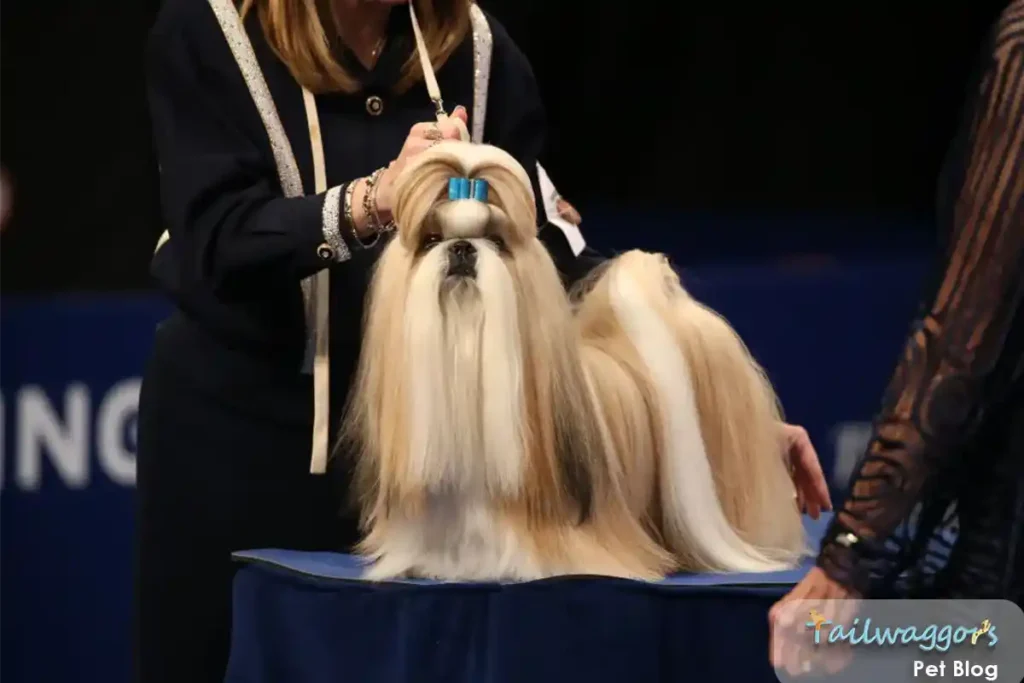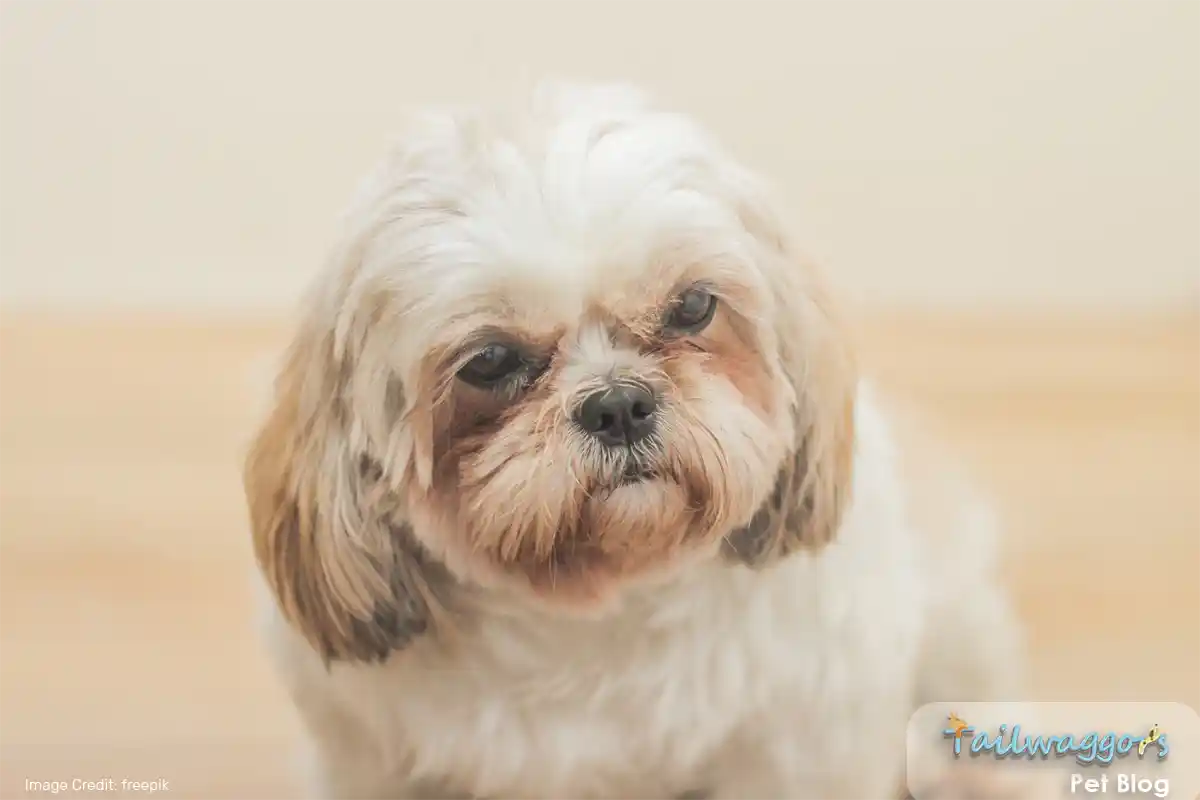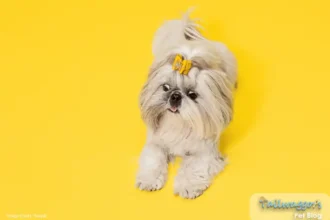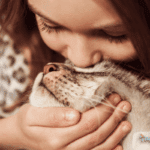Expert-reviewed guide to understanding, preventing, and treating tear stains in your Shih Tzu
Understanding Tear Stains in Shih Tzus
If you’ve noticed reddish-brown stains beneath your Shih Tzu’s eyes, you’re not alone. These tear stains, while common, can be both concerning and frustrating for pet parents. As a breed known for their expressive eyes and beautiful facial features, Shih Tzus are particularly prone to tear staining, but understanding why this happens is the first step to effective management.
What Are Tear Stains?
Tear stains, medically known as epiphora, appear as reddish-brown discoloration beneath the eyes. These stains occur when tears containing porphyrins (naturally occurring iron-containing red blood cell breakdown compounds found in tears, saliva and urine) oxidize upon contact with air and accumulate on the fur. This results in the reddish-brown stains which is more noticeable in light-colored fur and longer UV exposures. However, other contributors, such as yeast infections (Malassezia) and bacterial growth, can also play a role. While all dogs produce tears to keep their eyes healthy, certain breeds like Shih Tzus are more susceptible to visible staining.

Why Shih Tzus Are Particularly Affected
Shih Tzus face several breed-specific challenges that contribute to tear staining:
- Facial Structure: Shih Tzu brachycephalic (flat-faced or short-nosed) anatomy often leads to shallow eye sockets and protruding eyes, making it harder for their tears to drain properly down their tear ducts. This leads to their tears to overflow, resulting in the reddish-brown staining down their face.
- Hair Growth Patterns: The continuous hair growth around their eyes can irritate and increase tear production.
- Tear Duct Anatomy: Many Shih Tzus have naturally smaller or occasionally blocked tear ducts.
- Light-Colored Fur: The staining is particularly visible on their typically light-colored facial fur.
🌟 Want to learn more about the unique traits of Shih Tzus? Discover their royal history, charming personalities, and care needs in our Ultimate Guide to Shih Tzu Dogs.
Common Causes of Tear Stains
Understanding the root causes of tear stains is crucial for effective treatment. Here are several key factors:
While there’s limited scientific evidence, some pet owners report that high mineral content in water or artificial additives in food exacerbate staining. Switching to filtered water and a high-quality, additive-free diet may reduce tear stains.
🍖 Curious about the best diet for your Shih Tzu? Learn how to prevent obesity and ensure a healthy, balanced diet in our Shih Tzu Diet Guide.
Health Implications and When to Worry
While tear stains are often cosmetic, they can sometimes indicate underlying health issues. Watch for these warning signs:
- Excessive tearing
- Eye discharge that’s yellow or green
- Squinting or eye discomfort
- Rubbing at the eyes
- Changes in vision
- Strong odor around the eyes
Shih Tzu Tear Staining Prevention Guide
Daily Face Care Routine
Morning Cleansing
- ✓ Gently wipe eyes with warm water
- ✓ Use pet-safe eye wipes
- ✓ Pat area dry thoroughly
Evening Maintenance
- ✓ Remove any debris
- ✓ Clean tear stain area
- ✓ Keep facial hair trimmed
Environmental Modifications
Water Quality
- ✓ Use filtered water
- ✓ Consider stainless steel bowls
- ✓ Clean water bowls daily
Home Environment
- ✓ Reduce dust and allergens
- ✓ Use air purifiers
- ✓ Keep face dry after baths
Dietary Considerations
Research from the International Journal of Veterinary Science suggests:
Recommended
- ✓ High-quality protein sources
- ✓ Grain-free options for sensitive dogs
- ✓ Probiotics for immune support
- ✓ Fresh, clean water always available
Avoid
- ✗ Artificial preservatives
- ✗ Food dyes
- ✗ Excessive mineral content
- ✗ Common allergens if sensitive
The moist environment under the eyes can lead to yeast and bacterial infections, which may cause additional discoloration and odor. Prompt veterinary attention is essential to address these issues.
We advise using pet-safe wipes instead of a damp cloth ( a cloth can spread infection easier). And to use a new and clean wipe on each eye. Do not cross-contaminate. Also after wiping, use a clean section on the wipe. Gently clean tear buildup daily, avoiding vigorous scrubbing to prevent skin irritation.

Treatment Solutions
Natural Remedies
While these remedies can be effective, they should complement—not replace—veterinary advice for persistent or severe cases of tear staining. Not all remedies found on the internet works or could cause more harm than good. For light staining try:
Coconut Oil
- Apply a small, pea-sized amount to the stained area (avoiding the eyes).
- It’s natural antimicrobial and moisturizing properties help prevent irritation and infection.
- Avoid application near the eyes themselves to prevent discomfort.
Chamomile Tea
- Use as a cool compress, after brewing and cooling the tea completely.
- Soothes irritation and reduces inflammation.
- Ensure it is free of added sweeteners or flavorings.

Vets Preferred Eye Cleaner for Dogs – Dog Eye Wash Drops for Infection & Tear Stain Remover – Improves Allergy Symptoms, Infections & Runny Eyes – Dog Eye Drops Rinse for Every Dog – 4 Oz
Does your dog suffer from red, runny eyes or do you worry about mucus build-up? Keep your dog’s eyes clear and healthy year-round with our mild dog eye wash!
Professional Products
Recommended by the World Small Animal Veterinary Association (WSAVA):
Enzyme-Based Cleaners
- Effectively break down proteins and organic molecules causing stains.
- Safe for daily or as-needed use.

HICC PET Eyes Wipes for Dogs & Cats – Gently Remove Tear Stain, Eye Debris, Discharge, Mucus Secretions – Coconut Oil Pet Cleaning Grooming Deodorizing Wipes for Eyes, Wrinkle, Face – 100pcs
Remove Discharge & Mucus, booger, Reduce Tear Stains, Relieves itching and infection.
Professional Whitening Products
- Specifically formulated for pets with tear-stain-safe ingredients.
- Only use under veterinary guidance to avoid harsh chemicals.

HICC PET Eyes Wipes for Dogs & Cats – Gently Remove Tear Stain, Eye Debris, Discharge, Mucus I-LID ’N LASH Vet Pump Pet Tear Stain Remover for Dogs (50 ml) | Prevents Eye Tear Stains | Odor Eye Cleaner | Cats & Dogs Tear Stain Remover with Hyaluronic Acid | Non Antibiotic Eye Wash Solution
Remove Discharge & Mucus, booger, Reduce Tear Stains, Relieves itching and infection.
Professional Grooming Tips
From certified pet groomers, these practices ensure optimal eye health and minimize staining:
Regular Trimming
- Keep facial hair trimmed to at least 1/4 inch around the eyes.
- Prevents hair from wicking tears into the fur, reducing staining.
- Use blunt-nosed scissors to avoid accidental injury, or
- Use professional grooming services if unsure of proper technique and safety precautions.
Professional Tools
- Use round-tipped scissors for safe trimming.
- Fine-toothed combs help remove tear crusts and debris effectively.
- Consider investing in specialized eye-comb tools for targeted cleaning.
Professional Tools
here are some highly-rated products available on Amazon

CONAIRPRO Dog & Dat 6″ Round Tip Shears, Dog Grooming Scissors, Round Tip Shears For Safe Pet Trimming, Comfortable Ergonomic Design
 Petpost | Tear Stain Remover Comb for Dogs – Extra Fine Tooth Rake Gently & Effectively Gets Rid of Crust, Mucus, and Gunk Around Your Shih Tsu or Maltese Blue
Petpost | Tear Stain Remover Comb for Dogs – Extra Fine Tooth Rake Gently & Effectively Gets Rid of Crust, Mucus, and Gunk Around Your Shih Tsu or Maltese BlueWhat Products to Avoid?
Only use products specifically formulated for dogs, as improper pH levels or harsh chemicals in human products can cause irritation or more harm or damage.
Not all products are safe for dogs, especially for breeds with sensitive eyes like Shih Tzu’s.
- Do not use low-quality wipes or unapproved home remedies, as they may scratch the skin or spread bacteria.
- Avoid human eye care products: These may have pH levels unsuitable for dogs.
- Steer clear of products containing bleach, peroxide, or alcohol: Harsh chemicals can worsen irritation.

How to Safely Clean Tear Stains on Your Shih Tzu
Keeping your Shih Tzu’s eyes clean and free from tear stains is essential for their comfort and overall health. With a gentle touch and the right supplies, this process can be quick, easy, and stress-free for both you and your furry companion.
What You’ll Need
To clean your Shih Tzu’s tear stains effectively, gather these essential items:
- Sterile saline solution or vet-approved eye wipes (gentle and safe)
- A soft cloth or tissue (for drying)
- Vet-recommended tear stain remover product (optional but effective)
- A fine-toothed comb (to tackle stubborn tear crusts)
Step-by-Step Instructions
- Prepare the Cleaning Area
Find a quiet spot where your Shih Tzu feels relaxed. Sit them comfortably on your lap or a soft surface to help them stay calm. Have your supplies within easy reach. - Gently Clean the Tear Stains
Using a sterile saline solution or a vet-approved eye wipe, gently clean the area around your Shih Tzu’s eyes. Always wipe from the inner corner of the eye outward to prevent debris from being pushed into their eye. - Tackle Stubborn Tear Crusts
If there are hardened tear crusts, carefully use a fine-toothed comb to remove them. Be gentle to avoid pulling on the fur or irritating the sensitive skin around the eyes. If the crust is too hard, moisten it with saline first. - Dry the Area Thoroughly
Once the area is clean, pat it dry with a soft cloth or tissue. Keeping the area dry is crucial to prevent bacteria and yeast from thriving. - Apply a Tear Stain Remover (Optional)
If the stains persist, apply a vet-recommended tear stain remover product. Follow the instructions carefully, ensuring the product doesn’t get into your dog’s eyes. These products can help brighten the stained fur over time. - Reward Your Shih Tzu
Praise your Shih Tzu and give them their favorite treat. Positive reinforcement makes future cleanings easier and helps them associate the process with a happy experience.
Make tear stain cleaning a regular part of your Shih Tzu’s grooming routine. A consistent schedule not only prevents stains but also keeps your dog feeling comfortable and looking their best.

Expert Maintenance Tips
Daily Care Checklist
Long-Term Management
Consistent Routine
- • Establish daily cleaning schedule
- • Monitor changes
- • Keep supplies ready
Regular Checkups
- • Schedule grooming appointments
- • Veterinary eye examinations
- • Track effectiveness of treatments
When to Seek Professional Help
Consult your veterinarian if:
Veterinary Care May Include:
Tear Duct Flushing
This procedure clears blocked tear ducts and restores normal drainage.
Antibiotics or Medicated Drops
Only used if an infection is confirmed. Avoid using antibiotics for cosmetic purposes to prevent resistance.
Diagnostics for Allergies or Infections
Identifying the root cause ensures effective treatment.
Conclusion
While tear stains are common in Shih Tzus, they’re manageable with the right approach. By understanding the causes and implementing proper prevention strategies, you can significantly reduce tear staining and maintain your pet’s eye health and appearance.
Remember that each dog is unique, and what works for one may not work for another. Be patient as you find the right combination of treatments for your Shih Tzu, and always consult with your veterinarian before starting any new treatment regimen.
Consistent cleaning, proper grooming, and addressing underlying causes like allergies or diet are crucial for managing tear stains. Always consult your veterinarian for personalized advice.
🏃 Exercise is key to your Shih Tzu’s overall health! Explore top activities to keep them fit and happy in our Shih Tzu Exercise Requirements Guide.
Want to read more on Shih Tzus?
- Ultimate Guide to Shih Tzu Dogs.: Discover their royal history, and charming personalities.
- Shih Tzu Diet Guide: Learn how to prevent obesity and ensure a healthy, balanced diet.
- Shih Tzu Exercise Requirements Guide: Explore top activities to keep them fit and happy.
🐾 Love Shih Tzus as much as we do? 🐶
Share this guide with your fellow dog lovers and let them discover everything they need to know about keeping their Shih Tzu happy and healthy.
💌
Shih Tzu Tear Stains: Frequently Asked Questions
Complete Guide to Shih Tzu Tear Stains
Tear stains themselves are primarily a cosmetic concern, but the moist environment they create can potentially lead to bacterial or yeast growth if not properly managed. The American Kennel Club (AKC) emphasizes that while normal staining isn’t harmful, you should consult a veterinarian if you notice changes in discharge color, consistency, or signs of discomfort.
According to the World Small Animal Veterinary Association (WSAVA), with consistent care and proper management, you may see noticeable improvements within 2-4 weeks. However, complete results might take up to 8 weeks as new fur grows in. The key is maintaining a regular cleaning routine and addressing any underlying causes.
Tear stains rarely disappear without intervention, especially in adult Shih Tzus. While puppies may experience temporary staining during teething, tear stains in adult Shih Tzus typically require active management. The Merck Veterinary Manual notes that due to their facial anatomy, Shih Tzus often need ongoing maintenance to manage tear stains effectively.
For effective daily cleaning:
- Use sterile saline or vet-approved eye wipes
- Wipe from the inner to outer corner of the eye never using the same wipe on both eyes to avoid irritation and spreading infection.
- Dry the area gently after cleaning, avoid vigorous scrubbing
- Apply only vet-recommended tear stain products
Yes, diet can significantly impact tear staining. High-quality dog foods without artificial additives, preservatives, or dyes are recommended. The AKC suggests that switching to a premium, dye-free diet and ensuring clean, filtered water can help reduce tear staining in many cases.
Several safe home approaches include:
- Using filtered water to reduce mineral exposure
- Keeping stainless steel bowls to prevent bacterial growth
- Applying cooled chamomile tea compresses to soothe irritation
Always consult your veterinarian before trying any home remedies. Not everything on the internet works.
Yes, keeping the hair around the eyes trimmed helps prevent tear staining by reducing tear wicking into the fur. Use round-tipped scissors for safety, or better yet, have a professional groomer maintain the eye area during regular grooming sessions.
Prevention requires a comprehensive approach:
- Clean your dog’s eyes daily
- Use filtered water to reduce mineral exposure
- Maintain regular grooming schedules
- Feed a high-quality diet without artificial additives
- Address any underlying health issues with your veterinarian
Tear stains commonly appear during teething, typically between 4-6 months of age. While some puppies may experience temporary staining during teething, permanent staining patterns often develop as the dog’s facial structure matures. Regular maintenance from an early age can help manage this condition.
Antibiotics are not recommended for cosmetic purposes. The WSAVA strongly advises against using antibiotics like Tylosin unless prescribed by a veterinarian for a diagnosed infection. Using antibiotics without proper medical indication can contribute to antimicrobial resistance and may have unwanted side effects.
The reddish-brown color comes from porphyrins, natural iron-containing compounds in tears that oxidize when exposed to air. These compounds are more noticeable on light-colored fur, which is why they’re particularly visible on many Shih Tzus. UV exposure can intensify the discoloration.
Yes, allergies are a common cause of excessive tearing that can lead to staining. Environmental allergens, food sensitivities, and seasonal changes can all contribute to increased tear production. Working with your veterinarian to identify and manage allergies can help reduce tear staining.
The WSAVA recommends cleaning at least twice daily to remove tear buildup and prevent staining. Additional cleaning after outdoor activities or meals can be beneficial. Remember that consistency in cleaning is more important than frequency beyond the recommended twice-daily minimum. There is no need for overdoing it.
Avoid using:
- Human eye products (not pH-balanced for dogs)
- Hydrogen peroxide (can irritate or damage tissues)
- Non-regulated whitening products
Only use products specifically formulated for dogs, as improper pH levels or harsh chemicals in human products can cause irritation or harm.
Yes, using stainless steel or ceramic bowls can help reduce tear staining by minimizing bacterial growth. These materials are easier to clean and maintain than plastic. Combining this with filtered water can help reduce mineral-related staining. Remember to clean bowls daily and changing them to stainless steel bowls for the best results.












